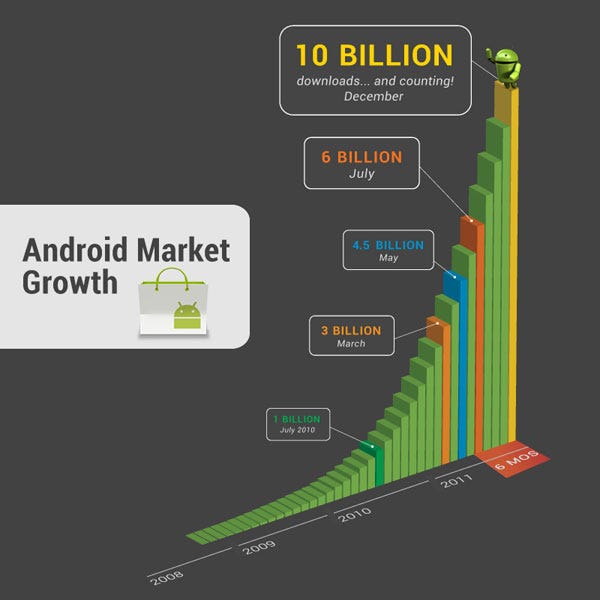Over 10 billion Android apps downloaded
Web giant Google this week trumpeted the ten billionth download from its Android app store, having racked up no less than four billion downloads in the past six months.
December 8, 2011

Web giant Google this week announced the ten billionth download from its Android Market application store, having racked up no less than four billion downloads in the past six months.
Android Market hit the six billion downloads mark in July of this year, up from one billion in July 2010. The growth curve has accelerated dramatically over the past twelve months, from three billion in March 2011 to 4.5 billion downloads by May, now approaching a growth rate of one billion app downloads per month.
By contrast the Apple App Store hit 15 billion downloads in July, suggesting that Android Market is catching up on iOS in terms of numbers.
In related news, Android handset vendors Motorola and Sony Ericsson have released information about the process for deploying operating system updates to in-market handsets. The move was intended to quell impatient smartphone users in the wake of the release of Android 4.0 Ice Cream Sandwich (ICS).
The OS, which brings together features from the smartphone and tablet worlds, made its debut on the Samsung Galaxy Nexus in November and was released to the industry around the same time. The software is in great demand as an update, having already made it to rooted devices via the custom ROM and phone hacking community. But it may take a couple of months to hit existing devices like the Samsung Nexus S and Motorola Xoom via the official channels.
The bottleneck, according to Motorola and Sony Ericsson, is the carriers, which have to certify each and every change before an update can be rolled out to users on their networks.
Motorola said it is currently assessing the source code, and over the next month will be determining which devices will get the upgrade. From there the vendor merges and adapts the new release for different device hardware architectures and carrier customisations as well as integrating all of the Motorola-specific software enhancements into the source code. Next, vendors stabilise and ‘bake’ the result to drive out bugs before submitting the upgrade to the carriers for certification. This is the part that takes the longest as the carrier’s lab has to qualify and test the upgrade, so there may be a two-month preparation cycle to enter a carrier lab cycle of one to three months, Motorola said.
Finally, after some customer testing, a final release is delivered publicly to the user base.

android-graph
About the Author
You May Also Like





.png?width=300&auto=webp&quality=80&disable=upscale)




.png?width=300&auto=webp&quality=80&disable=upscale)


_1.jpg?width=300&auto=webp&quality=80&disable=upscale)